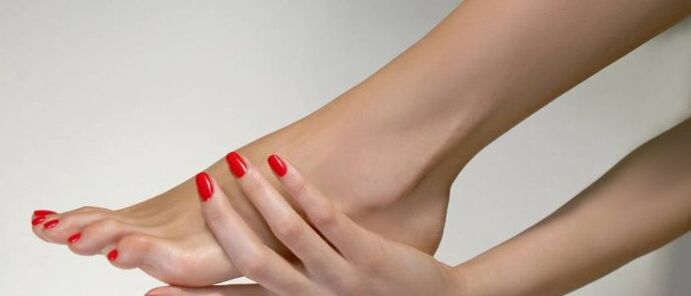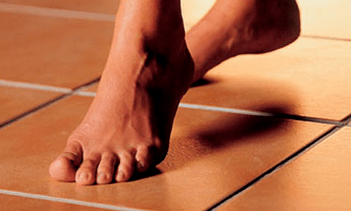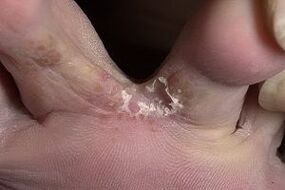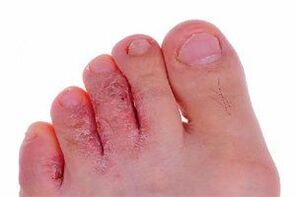If a person has a foot fungus, it is important to start treatment in a timely and adequate manner. The fact is that a fungal disease of the skin of the feet is contagious and if you do not immediately start fighting the disease, all members of the patient's family are at risk of getting an infection. Treatment is prescribed by a doctor, will depend on the type of pathology, the degree of skin damage, as well as the general condition of the person.

Causes of the appearance of fungus on the feet
When it enters the skin of the feet, the fungus does not always cause mycoses and in order for the first symptoms to appear, negative factors must affect the human body. The following negative causes affect the development of mycosis:

- weakening of the body's immune forces;
- use of heavy and toxic drugs;
- non-compliance with the rules of foot and toe hygiene;
- the presence of cracks, wounds and scratches on the toes and feet, through which mold spores can enter the body.
The places of fungal infection are the wet floors of swimming pools, baths and showers in gyms.
A fungal infection enters the body through household contact when an adult or child comes in contact with a diseased carrier or objects that are inhabited by fungal spores. Often, foot fungus can be found in public places - locker rooms, showers, swimming pools, on the beach. The disease can also be passed on when you wear someone else's shoes, in which pathogenic spores live. Failure to follow the basic rules of hygiene leads to undesirable consequences that provoke fungal pathologies of the feet and nails. The carrier may not always be able to detect in time that he has a foot fungus, as the symptoms only appear in a combination of adverse circumstances. But such a person is still contagious, and it is dangerous for loved ones who are also at risk of getting an infectious infection.
Symptoms and types
Mycosis of the feet is of the following forms:
- quasime;
- dyshidrotic;
- intertwined;
- onychomycosis;
- candidate.
Squamous
The initial symptoms of fungi of this form can be found only on one foot, however, with the progression of the pathology, a manifestation is observed on the other foot. The disease looks like a skin defect in which inflammation forms, covered with skin. Squamous fungus of the foot is not always characterized by itching and discomfort, so for many this disease goes unnoticed, and it is impossible to determine without a laboratory test.
If foot fungus does not heal in time, the infectious lesion passes into the foot, then it will be much harder to deal with the problem. Fungi can also be localized in calves, however, these complications are rare.
Dyshydrotike
The first signs of fungus on the feet of this form are characterized by the formation of bubbles in the arch of the foot, which gradually increase in size and reach a diameter of up to 10 mm. After the opening of the rash, it hurts, in its place erosion occurs. The sites of injury hurt, there are cases of bacterial inflammation. Once the skin in the diseased areas heals, the disease progresses to a squamous form. With a dyshidrotic variety, the skin on both feet is rarely affected, if you do not start treatment on time, a neglected form develops, in which the stages of remission will alternate with deterioration.
interactive

Interstitial or interdigital foot fungus is the most common form of skin disease.
This type of foot fungus is considered the most common. Most often, the skin between the 4th and 5th fingers is affected. The disease manifests itself in the form of the formation of dead areas, with scales that melt from the normal layer of the epidermis.
If you do not provide help in time, then the cracked places start to get wet, the patient feels pain and itching. Further, wounds and erosions form in the affected areas, which are difficult to eliminate.
If you do nothing and ignore the symptoms, the disease progresses to a chronic form, which is prone to frequent relapses.
Onychomycosis
The disease is characterized by the fact that the fungus is localized on the nails and toes. First, toenail fungus manifests itself in the form of a lesion of the free edge of the nail, in which spots and streaks with a yellow tinge are formed. There are the following types of toenail and toenail fungus:
- Hypertrophic. The nail plate thickens, turns yellow, is easily destroyed. Beneath the damaged foci, the affected skin of the finger is visible.
- atrophic. The nails thin, quickly destroy and the dermis beneath it becomes keratinized.
- Onychomycosis caused by the fungus. The nail plate thins, its color becomes black, brown, yellow or green. The disease is a complication of 2 previous types of pathology.
candida

The fungus infects the skin between the fingers, without proper treatment leads to bacterial infections.
This type of disease is caused by yeast-like pathogenic fungi, whose name is Candida. Focuses of inflammation are often localized on the skin between 3 and 4 or 4 and 5 fingers. The tissues in these places become inflamed, edema develops, and often a bacterial complication joins.
Candida fungi are a type of microorganism that infects the mucous membranes and outer skin of a person. Normally, Candida is present in the human body in limited quantities. However, with a decrease in immunity, it may show increased activity, causing discomfort to the patient.
If the fungus is not removed in the initial stage, pustules, cracks and erosions form, which are difficult to get rid of even with the help of powerful drugs.
Diagnostic methods
In order for foot fungus treatment to be effective, it is important to determine the pathogen and make an accurate diagnosis. To do this, it is worth visiting a doctor, who often, after the first visual examination, will be able to determine the pathology. If the skin pathology seems suspicious or does not go away with treatment for a long time, it will be necessary to do a blood and urine test, as well as undergo an additional diagnostic study that will help determine the types ofpathogens and their susceptibility to antifungal drugs. To do this, a portion of the dermis is taken from the damaged area and examined under a microscope. To check for malignant cells in the tissue, samples are taken from the damaged areas for a biopsy.
What should be treated?

Fungal diseases are numerous, to distinguish them and to prescribe the appropriate treatment, laboratory tests are performed.
To cure foot fungus and prevent recurrence, you should contact a healthcare professional for advice and undergo diagnostic measures. If the diagnosis is correctly established, you can start therapy, in which drugs with systemic and local effects are used.
It is effective to treat it at an early stage, then during the therapy period you can take it with tools for external use in the form of creams, ointments and sprays. It is also possible to treat foot fungus with home remedies. If the disease has affected the deep layers of the dermis and nail plates, it is recommended to use a systemic remedy to fight the fungus.
Treatment with folk remedies is effective only in combination with the use of medications, otherwise the disease threatens to develop dangerous complications.
Medication treatment
An effective and efficient medicine should be prescribed by a doctor. If you self-medicate and ignore the advice of a specialist, you can provoke serious complications that the most effective medicine will not be able to cope with right away.
Therapy with folk remedies
Treatment of foot fungus with folk remedies at home should be agreed with the doctor. It is important to know that powerful medicines are used to treat fungus of the feet and nails, folk remedies are allowed to be used as adjunctive therapy, as it is ineffective to fight the disease yourself at home. There are various recipes that use medicinal herbs that have antimicrobial, disinfectant and wound healing properties. A popular remedy for a fungus is affordable and inexpensive, but which home method is best to use and what kind of prescription is appropriate in a particular case, you should consult a doctor. The best recipes are below:
- A decoction of chamomile, plantain and offspring. Mix the ingredients, taking every 1 tablespoon. l. Put everything in a saucepan and pour 1 liter of hot water, bring to a boil and simmer for 10 minutes. After the soup, strain and wash the affected hands, feet and other body parts before going to bed. The essence of the procedure is to perform it regularly, then this method will be effective and will help in faster treatment of fungi.
- Onion and St. John's wort infusion. Peel an onion and cut it into 4 pieces. St. John's wort should be dried. Add onion and 50 g St. John's wort 2, 5 liters of boiling water. Wrap the container with raw material and let it inject for a day. In the evening, apply an infusion compress to the affected areas.
prevention
The best preventive measure in the fight against fungi that can prevent the disease is strengthening the protective properties of the body. This method is cheap, but more effective and efficient. Medical and alternative methods of treatment must be agreed with the doctor, any self-medication can provoke dangerous complications, which are then much more difficult and longer to cope.





























